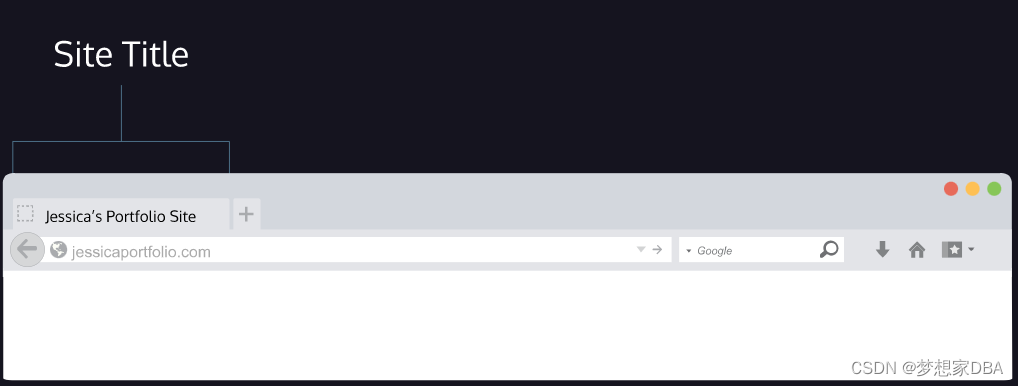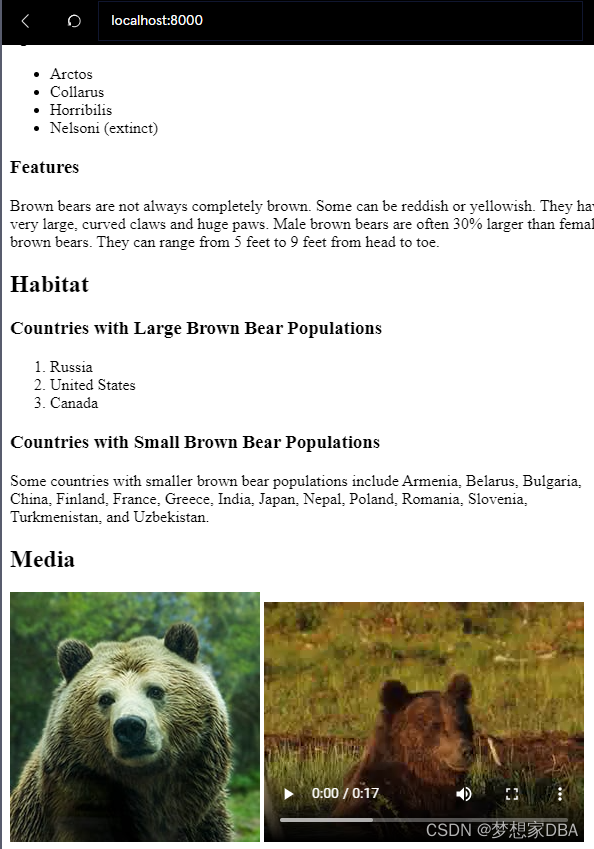Preparing for HTML
Now that we’ve learned about some of the most common HTML elements, it’s time to learn how to set up an HTML file.
HTML files require certain elements to set up the document properly. We can let web browsers know that we are using HTML by starting our document with a document type declaration.
<!DOCTYPE html> This declaration is an instruction, and it must be the first line of code in your HTML document. It tells the browser what type of document to expect, along with what version of HTML is being used in the document. For now, the browser will correctly assume that the html in <!DOCTYPE html> is referring to HTML5, as it is the current standard.
In the future, however, a new standard will override HTML5. To make sure your document is forever interpreted correctly, always include <!DOCTYPE html> at the very beginning of your HTML documents.
Lastly, HTML code is always saved in a file with an .html extension.
The <html> tag
The <!DOCTYPE html> declaration provides the browser with two pieces of information (the type of document and the HTML version to expect), but it doesn’t actually add any HTML structure or content.
To create HTML structure and content, we must add opening and closing <html> tags after declaring <!DOCTYPE html>:
<!DOCTYPE html>
<html>
</html>Anything between the opening <html> and closing </html> tags will be interpreted as HTML code. Without these tags, it’s possible that browsers could incorrectly interpret your HTML code.
The Head
you’ve done two things to set up the file properly:
- Declared to the browser that your code is HTML with
<!DOCTYPE html> - Added the HTML element (
<html>) that will contain the rest of your code.
Remember the <body> tag? The <head> element is part of this HTML metaphor. It goes above our <body> element.
The <head> element contains the metadata for a web page. Metadata is information about the page that isn’t displayed directly on the web page. Unlike the information inside of the <body> tag, the metadata in the head is information about the page itself. You’ll see an example of this in the next exercise.
The opening and closing head tags typically appear as the first item after your first HTML tag:
<head>
</head>Page Titles
A browser’s tab displays the title specified in the <title> tag. The <title> tag is always inside of the <head>.
<!DOCTYPE html>
<html>
<head>
<title>My Coding Journal</title>
</head>
</html>Where Does the Title Appear?
So far, we have learned about:
<!DOCTYPE html>, the declaration specifying the version of HTML for the browser- The
<html>tags that enclose all of your HTML code - The
<head>tag that contains the metadata of a webpage, such as its<title>

Linking to Other Web Pages
One of the powerful aspects of HTML (and the Internet), is the ability to link to other web pages.
You can add links to a web page by adding an anchor element <a> and including the text of the link in between the opening and closing tags.
<a>This Is A Link To Wikipedia</a>The anchor element in the example above is incomplete without the href attribute. This attribute stands for hyperlink reference and is used to link to a path, or the address to where a file is located (whether it is on your computer or another location). The paths provided to the href attribute are often URLs.
<a href="https://www.wikipedia.org/">This Is A Link To Wikipedia</a>Opening Links in a New Window
The target attribute specifies how a link should open.
It’s possible that one or more links on your web page link to an entirely different website. In that case, you may want users to read the linked website, but hope that they return to your web page. This is exactly when the target attribute is useful!
For a link to open in a new window, the target attribute requires a value of _blank. The target attribute can be added directly to the opening tag of the anchor element, just like the href attribute.
<a href="https://en.wikipedia.org/wiki/Brown_bear" target="_blank">The Brown Bear</a>Linking to Relative Page
The example above shows three different files — about.html, contact.html, and index.html in one folder.
HTML files are often stored in the same folder, as shown in the example above. If the browser is currently displaying index.html, it also knows that about.html and contact.html are in the same folder. Because the files are stored in the same folder, we can link web pages together using a relative path.
<a href="./contact.html">Contact</a>Linking At Will
You’ve probably visited websites where not all links were made up of text. Maybe the links you clicked on were images or some other form of content.
<a href="https://en.wikipedia.org/wiki/Opuntia" target="_blank">Prickly Pear</a>Text-only links, however, would significantly decrease your flexibility as a web developer!
Thankfully, HTML allows you to turn nearly any element into a link by wrapping that element with an anchor element. With this technique, it’s possible to turn images into links by simply wrapping the <img> element with an <a> element.
<a href="https://en.wikipedia.org/wiki/Opuntia" target="_blank"><img src="https://www.Prickly_Pear_Closeup.jpg" alt="A red prickly pear fruit"/></a>In the example above, an image of a prickly pear has been turned into a link by wrapping the outside of the <img> element with an <a> element.
<!DOCTYPE html>
<html>
<head>
<title>Brown Bears</title>
</head>
<body>
<a href="./index.html">Brown Bear</a>
<a href="./aboutme.html">About Me</a>
<h1>The Brown Bear</h1>
<div id="introduction">
<h2>About Brown Bears</h2>
<p>The brown bear (<em>Ursus arctos</em>) is native to parts of northern Eurasia and North America. Its conservation status is currently <strong>Least Concern</strong>.<br /><br /> There are many subspecies within the brown bear species, including the
Atlas bear and the Himalayan brown bear.</p>
<a href="https://en.wikipedia.org/wiki/Brown_bear" target="_blank">Learn More</a>
<h3>Species</h3>
<ul>
<li>Arctos</li>
<li>Collarus</li>
<li>Horribilis</li>
<li>Nelsoni (extinct)</li>
</ul>
<h3>Features</h3>
<p>Brown bears are not always completely brown. Some can be reddish or yellowish. They have very large, curved claws and huge paws. Male brown bears are often 30% larger than female brown bears. They can range from 5 feet to 9 feet from head to toe.</p>
</div>
<div id="habitat">
<h2>Habitat</h2>
<h3>Countries with Large Brown Bear Populations</h3>
<ol>
<li>Russia</li>
<li>United States</li>
<li>Canada</li>
</ol>
<h3>Countries with Small Brown Bear Populations</h3>
<p>Some countries with smaller brown bear populations include Armenia, Belarus, Bulgaria, China, Finland, France, Greece, India, Japan, Nepal, Poland, Romania, Slovenia, Turkmenistan, and Uzbekistan.</p>
</div>
<div id="media">
<h2>Media</h2>
<a href="https://en.wikipedia.org/wiki/Brown_bear" target="_blank"><img src="https://content.codecademy.com/courses/web-101/web101-image_brownbear.jpg" /></a>
<video src="https://content.codecademy.com/courses/freelance-1/unit-1/lesson-2/htmlcss1-vid_brown-bear.mp4" height="240" width="320" controls>Video not supported</video>
</div>
</body>
</html>
Linking to Same Page
At this point, we have all the content we want on our page. Since we have so much content, it doesn’t all fit on the screen. How do we make it easier for a user to jump to different portions of our page?
When users visit our site, we want them to be able to click a link and have the page automatically scroll to a specific section.
In order to link to a target on the same page, we must give the target an id, like this:
<p id="top">This is the top of the page!</p>
<h1 id="bottom">This is the bottom! </h1>In this example, the <p> element is assigned an id of “top” and the <h1> element is assigned “bottom.” An id can be added to most elements on a webpage.
An id should be descriptive to make it easier to remember the purpose of a link. The target link is a string containing the # character and the target element’s id.
<ol>
<li><a href="#top">Top</a></li>
<li><a href="#bottom">Bottom</a></li>
</ol><!DOCTYPE html>
<html>
<head>
<title>Brown Bears</title>
</head>
<body>
<a href="./index.html">Brown Bear</a>
<a href="./aboutme.html">About Me</a>
<h1>The Brown Bear</h1>
<ul>
<li><a href="#introduction">Introduction</a></li>
<li><a href="#habitat">Habitat</a></li>
<li><a href="#media">Media</a></li>
</ul>
<div id="introduction">
<h2>About Brown Bears</h2>
<p>The brown bear (<em>Ursus arctos</em>) is native to parts of northern Eurasia and North America. Its conservation status is currently <strong>Least Concern</strong>.<br /><br /> There are many subspecies within the brown bear species, including the
Atlas bear and the Himalayan brown bear.</p>
<a href="https://en.wikipedia.org/wiki/Brown_bear" target="_blank">Learn More</a>
<h3>Species</h3>
<ul>
<li>Arctos</li>
<li>Collarus</li>
<li>Horribilis</li>
<li>Nelsoni (extinct)</li>
</ul>
<h3>Features</h3>
<p>Brown bears are not always completely brown. Some can be reddish or yellowish. They have very large, curved claws and huge paws. Male brown bears are often 30% larger than female brown bears. They can range from 5 feet to 9 feet from head to toe.</p>
</div>
<div id="habitat">
<h2>Habitat</h2>
<h3>Countries with Large Brown Bear Populations</h3>
<ol>
<li>Russia</li>
<li>United States</li>
<li>Canada</li>
</ol>
<h3>Countries with Small Brown Bear Populations</h3>
<p>Some countries with smaller brown bear populations include Armenia, Belarus, Bulgaria, China, Finland, France, Greece, India, Japan, Nepal, Poland, Romania, Slovenia, Turkmenistan, and Uzbekistan.</p>
</div>
<div id="media">
<h2>Media</h2>
<a href="https://en.wikipedia.org/wiki/Brown_bear" target="_blank"><img src="https://content.codecademy.com/courses/web-101/web101-image_brownbear.jpg"/></a>
<video src="https://content.codecademy.com/courses/freelance-1/unit-1/lesson-2/htmlcss1-vid_brown-bear.mp4" height="240" width="320" controls>Video not supported</video>
</div>
</body>
</html>Whitespace
The rest of this lesson will focus on some tools developers use to make code easier to interpret.
As the code in an HTML file grows, it becomes increasingly difficult to keep track of how elements are related. Programmers use two tools to visualize the relationship between elements: whitespace and indentation.
Both tools take advantage of the fact that the position of elements in a browser is independent of the amount of whitespace or indentation in the index.html file.
<body>
<p>Paragraph 1</p>
<p>Paragraph 2</p>
</body>A browser renders both examples the same way:
Paragraph 1 Paragraph 2
Indentation
The second tool web developers use to make the structure of code easier to read is indentation. The spaces are inserted using the space and tab bars on your keyboard.
<body>
<p>Paragraph 1</p>
<div>
<p>Paragraph 2</p>
</div>
</body>In the example above, Paragraph 1 and the <div> tag are nested inside of the <body> tag, so they are indented two spaces. The Paragraph 2 element is nested inside of the <div> tag, so it is indented an additional two spaces.
Comments
HTML files also allow you to add comments to your code.
Comments begin with <!-- and end with -->. Any characters in between will be ignored by your browser.
<!-- This is a comment that the browser will not display. -->
Including comments in your code is helpful for many reasons:
- They help you (and others) understand your code if you decide to come back and review it at a much later date.
- They allow you to experiment with new code, without having to delete old code.
<!-- Favorite Films Section -->
<p>The following is a list of my favorite films:</p>In this example, the comment is used to denote that the following text makes up a particular section of the page.
<!-- <p> Test Code </p> -->In the example above, a valid HTML element (a paragraph element) has been “commented out.” This practice is useful when there is code you want to experiment with, or return to, in the future.
HTML Tags
You now know all of the basic elements and set-up you need to structure an HTML page and add different types of content. With the help of CSS, very soon you’ll be creating beautiful websites!
- The
<!DOCTYPE html>declaration should always be the first line of code in your HTML files. This lets the browser know what version of HTML to expect. - The
<html>element will contain all of your HTML code. - Information about the web page, like the title, belongs within the
<head>of the page. - You can add a title to your web page by using the
<title>element, inside of the head. - A webpage’s title appears in a browser’s tab.
- Anchor tags (
<a>) are used to link to internal pages, external pages or content on the same page. - You can create sections on a webpage and jump to them using
<a>tags and addingids to the elements you wish to jump to. - Whitespace between HTML elements helps make code easier to read while not changing how elements appear in the browser.
- Indentation also helps make code easier to read. It makes parent-child relationships visible.
- Comments are written in HTML using the following syntax:
<!-- comment -->.






















 835
835











 被折叠的 条评论
为什么被折叠?
被折叠的 条评论
为什么被折叠?








